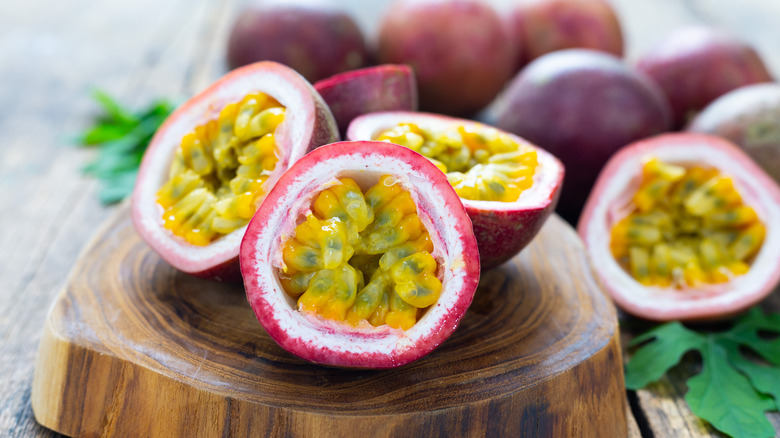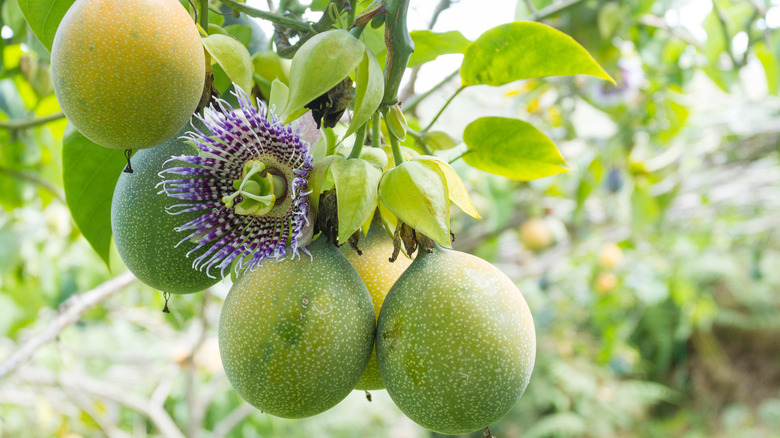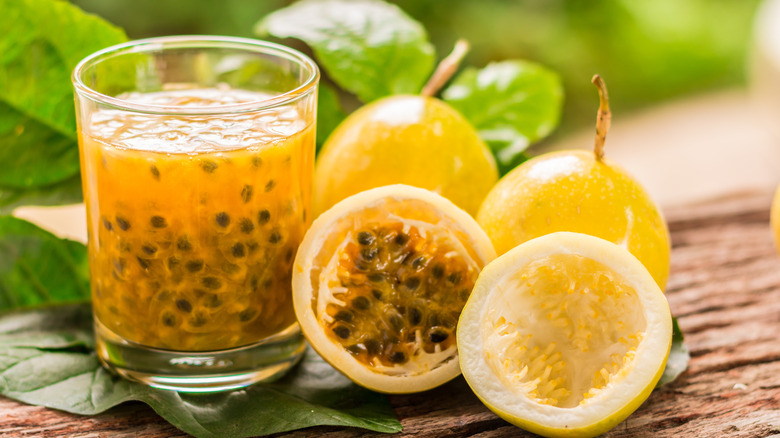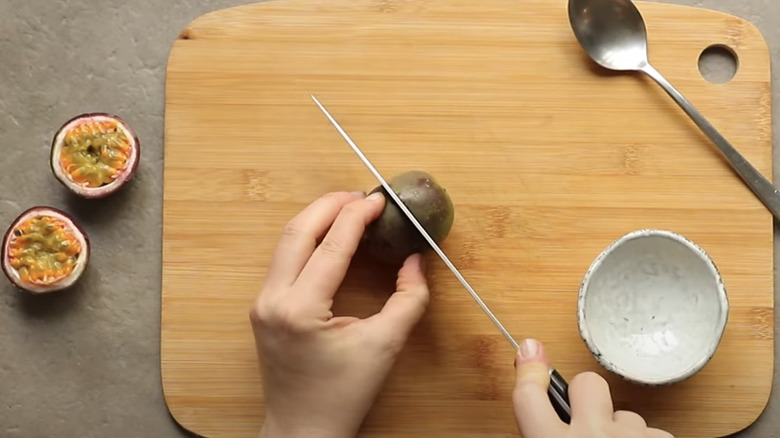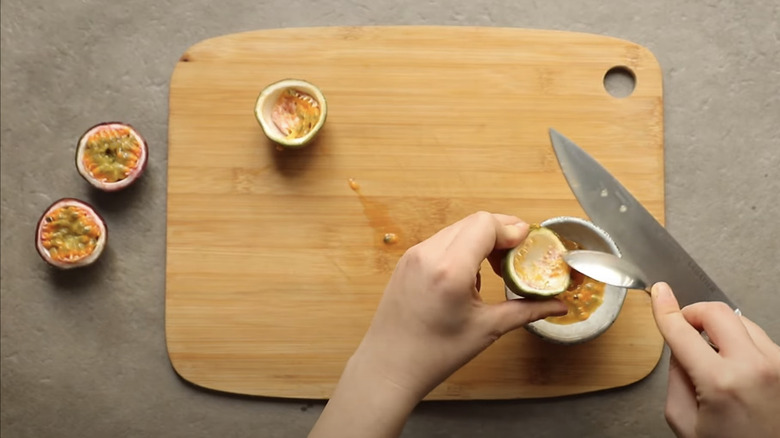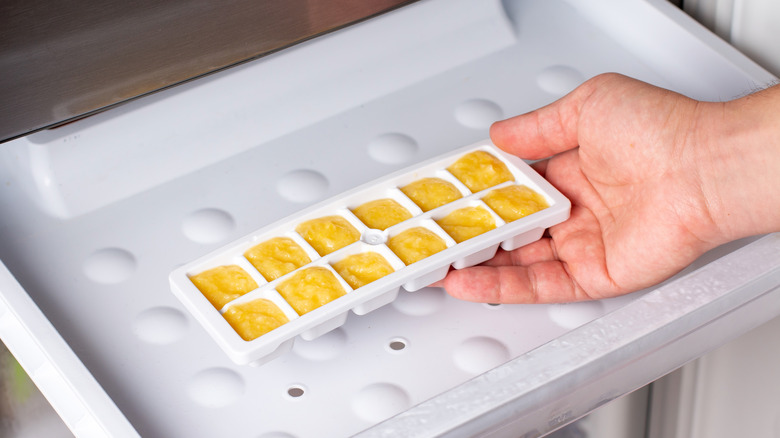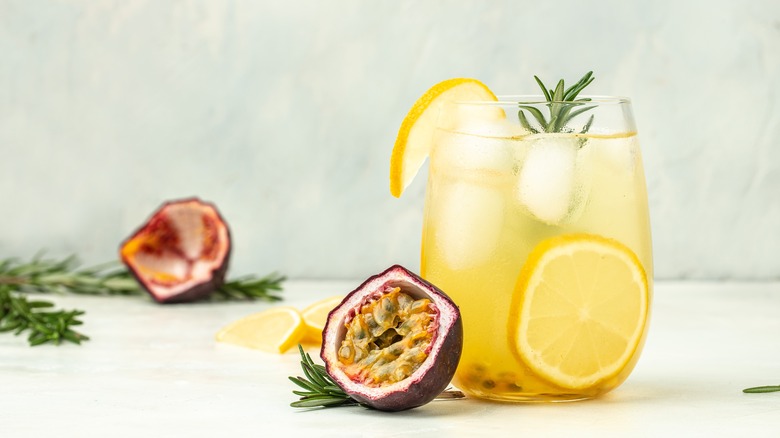How To Cut And Eat Passion Fruit
The passion fruit can be an intimidating fruit to those who have never tried — or prepared — it before. With its thick, dark peel and seed-filled center, it is not immediately obvious how to navigate a passion fruit, but you'll find it is well worth the effort! What it lacks on the outside, it more than makes up for on the inside. The tart, bright flavor of passion fruit juice is somewhat citrusy, but this fruit is more reminiscent of other tropical specialties, like mango and pineapple than it is of a lemon or even a milder lime.
Interested in giving it a go? To start, the only tools you need are a good serrated knife, a cutting board, and a spoon. Passion fruit is an extraordinary addition to a wide array of dishes and drinks, but first, try tasting it fresh all on its own. Here's everything you need to know about passion fruit to enjoy it from the comfort of your home.
What is passionfruit?
Passion fruit is a tropical fruit native to Brazil, which remains its global leading producer — though passion fruit is now also grown in warm climates throughout the world, including in Hawaii, Puerto Rico, California, and Florida. Its harvest season varies from place to place, but in Florida, for example, peak production happens from summer to fall, following the beautiful spring flowering season.
Though it is commonly thought that the passion fruit is named for an amorous feeling, its name actually derives from Catholic religious symbology based on the unusual shape of the flower. Compared to the masterpiece of petals that form the passion flower, the fruit is surprisingly plain in appearance. Passion fruit comes in different colors, including purple, red, and yellow, and varies in diameter from about the size of a ping pong ball to a baseball. This juice from this fruit is wonderfully versatile and vibrant in both color and flavor. The yellow pulp is littered with small black seeds, and — fortunately — these seeds are entirely edible and make for a very pleasant crunch.
Where and how to buy passion fruit
Thanks to its ever-growing popularity, it is becoming increasingly easy to purchase passion fruit — though you may have to search a little while to find it exactly as you want it. Passion fruit is sold whole in its fresh, raw form at some supermarkets, but it's more commonly marketed as packaged pulp or juice, which may be liquid or frozen. If you only need the juice of passion fruit, you can order it online directly from brands like Pitaya Foods, which sells it frozen in small, convenient cubes (like ice cubes but with a whole lot more flavor).
When buying fresh and intact passion fruit, don't be concerned if the skin of the fruit is wrinkled. In fact, the more wrinkly the fruit, the more ripe it is, which means it will be extra delicious and ready to eat right away. If the skin is still taut, leave the fruit out on your counter for a few days to ripen.
First, wash your passion fruit
The skin of the passion fruit is not edible, but it's still a good idea to wash it in order to clean off any bacteria or pesticides before eating its interior. This is especially important if you plan to eat the pulp directly from the skin or use the skins as containers for drinks or snacks, such as alcoholic passion fruit shots or miniature cups of passion fruit curd. Before you get to the fruit, make sure you wash your hands with hot soapy water, and wait to rinse your fruit until right before you're going to prepare it. When you're ready, simply rinse the passion fruit under clean running water as you would with any other fruit.
Cutting open your passionfruit
Once washed, place your clean passion fruit on a cutting board. Holding the fruit carefully, slice it in half with a sharp knife. Because the skin is so thick and tough, it may be easiest to use a serrated knife. Depending on how ripe the fruit is, some of the juice may gush out onto the cutting board. Each drop of passion fruit juice is packed with flavor and nutrients (including plenty of vitamin C!), so try not to lose any!
Scoop out the pulp and seeds
Using a spoon, scoop the pulp and seeds from both halves of the opened fruit and place them in a small bowl. The seeds are perfectly edible and can add a pleasant crunch and fun polka-dot appearance to dishes and drinks prepared with the whole interior of the fruit; however, if you prefer a smooth consistency, you can opt to strain out the seeds with a mesh strainer. Because the pulp is a touch gelatinous, you may need to use the back of the spoon to push the juice through the mesh sieve to really ensure you're getting every last drop possible.
Storing your passion fruit
If you buy passion fruit whole, you can store it at room temperature in a cool, dry place out of direct sunlight until ripe. Once it has fully ripened, place it in the refrigerator where it can be stored for up to two weeks. If you have more passion fruit that you know what to do with, you can also opt to keep some in the freezer — yes, even the whole fruit. So long as the fruit is placed in an airtight container, it can last up to eight months. When you're ready to eat it, all you need to do is allow the passion fruit to thaw on your countertop.
Passion fruit juice, on the other hand, can be stored in an airtight container in the fridge for just a few days or in the freezer for up to six months. If you have an ice cube tray available, you can pour the passion fruit juice into the tray, so that it is in neat portions when you're ready to enjoy it! Add is straight to cocktails as a delicious way to keep drinks cold without watering them down.
Ways to eat and drink passion fruit all day
There's a reason Monin — an international company that has manufactured flavors for food and beverage products for over a century — declared passion fruit the Flavor of the Year in 2022. Monin reported that the presence of passion fruit on menus in the U.S. increased 20% in the previous four years and is projected to grow ever more popular.
Passion fruit can be enjoyed in ways both sweet and savory, at every meal of the day from breakfast to lunch to dinner, as well as in your drinks, snacks, and desserts. At cocktail hour, try a passion fruit caipirinha, and when you're craving a sweet treat, make a batch of passion fruit caramels. For everything from salad dressings and salsas to cakes and curds, if a recipe calls for an acidic fruit juice (such as citrus or tropical fruits), you can easily substitute passion fruit juice instead. When paired with ginger, passion fruit goes particularly well with light meats, like chicken.

